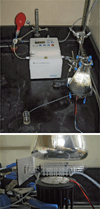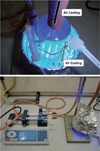The Development of Visible-Light Photoredox Catalysis in Flow
- PMID: 25484447
- PMCID: PMC4255365
- DOI: 10.1002/ijch.201300136
The Development of Visible-Light Photoredox Catalysis in Flow
Abstract
Visible-light photoredox catalysis has recently emerged as a viable alternative for radical reactions otherwise carried out with tin and boron reagents. It has been recognized that by merging photoredox catalysis with flow chemistry, slow reaction times, lower yields, and safety concerns may be obviated. While flow reactors have been successfully applied to reactions carried out with UV light, only recent developments have demonstrated the same potential of flow reactors for the improvement of visible-light-mediated reactions. This review examines the initial and continuing development of visible-light-mediated photoredox flow chemistry by exemplifying the benefits of flow chemistry compared with conventional batch techniques.
Keywords: Photochemistry; Radical reactions; Radicals; Redox chemistry.
Figures
















Similar articles
-
Free Radical Chemistry Enabled by Visible Light-Induced Electron Transfer.Acc Chem Res. 2016 Oct 18;49(10):2295-2306. doi: 10.1021/acs.accounts.6b00270. Epub 2016 Aug 16. Acc Chem Res. 2016. PMID: 27529484 Free PMC article.
-
Redox-neutral α-allylation of amines by combining palladium catalysis and visible-light photoredox catalysis.Angew Chem Int Ed Engl. 2015 Jan 26;54(5):1625-8. doi: 10.1002/anie.201409999. Epub 2014 Dec 10. Angew Chem Int Ed Engl. 2015. PMID: 25504920
-
Batch to flow deoxygenation using visible light photoredox catalysis.Chem Commun (Camb). 2013 May 14;49(39):4352-4. doi: 10.1039/c2cc37206a. Epub 2012 Nov 12. Chem Commun (Camb). 2013. PMID: 23142826
-
Radical carbon-carbon bond formations enabled by visible light active photocatalysts.Chimia (Aarau). 2012;66(6):394-8. doi: 10.2533/chimia.2012.394. Chimia (Aarau). 2012. PMID: 22871282 Review.
-
Recent Synthetic Applications of the Hypervalent Iodine(III) Reagents in Visible-Light-Induced Photoredox Catalysis.Front Chem. 2020 Sep 23;8:551159. doi: 10.3389/fchem.2020.551159. eCollection 2020. Front Chem. 2020. PMID: 33173767 Free PMC article. Review.
Cited by
-
Photochemical Approaches to Complex Chemotypes: Applications in Natural Product Synthesis.Chem Rev. 2016 Sep 14;116(17):9683-747. doi: 10.1021/acs.chemrev.5b00760. Epub 2016 Apr 27. Chem Rev. 2016. PMID: 27120289 Free PMC article. Review.
-
Photoinduced Organocatalyzed Atom Transfer Radical Polymerization (O-ATRP): Precision Polymer Synthesis Using Organic Photoredox Catalysis.Chem Rev. 2022 Jan 26;122(2):1830-1874. doi: 10.1021/acs.chemrev.1c00603. Epub 2021 Nov 29. Chem Rev. 2022. PMID: 34842426 Free PMC article. Review.
-
Redox Catalysis Facilitates Lignin Depolymerization.ACS Cent Sci. 2017 Jun 28;3(6):621-628. doi: 10.1021/acscentsci.7b00140. Epub 2017 Jun 7. ACS Cent Sci. 2017. PMID: 28691074 Free PMC article.
-
Synthesis of Chiral Tetrahydrofurans and Pyrrolidines by Visible-Light-Mediated Deoxygenation.European J Org Chem. 2017 Apr 18;2017(15):2130-2138. doi: 10.1002/ejoc.201700014. Epub 2017 Feb 28. European J Org Chem. 2017. PMID: 28529446 Free PMC article.
-
Photochemical diazidation of alkenes enabled by ligand-to-metal charge transfer and radical ligand transfer.Nat Commun. 2022 Dec 23;13(1):7881. doi: 10.1038/s41467-022-35560-3. Nat Commun. 2022. PMID: 36564375 Free PMC article.
References
-
- Wiles C, Watts P. Eur. J. Org. Chem. 2008;10:1655–1671.
-
- Trommsdorff H. Ann. Chem. Pharm. 1834;11:190–208.
-
- Ninomiya I, Naito T, editors. Best Synthetic Methods: Photochemical Synthesis. London: Academic Press; 1989.
-
- Hook BDA, Dohle W, Hirst PR, Pickworth M, Berry MB, Booker-Milburn KI. J. Org. Chem. 2005;70:7558–7564. - PubMed
- Goodell JR, McMullen JP, Zaborenko N, Maloney JR, Ho KF, Jensen C-H, Porco JA, Beeler AB. J. Org. Chem. 2009;74:6169–6180. - PMC - PubMed
- Bou-Hamdan FR, Seeberger PH. Chem. Sci. 2012;3:1612–1616.
- Tucker JW, Zhang Y, Jamison TF, Stephenson CRJ. Angew. Chem. Int. Ed. 2012;51:4144–4147. - PMC - PubMed
- Andrews RS, Becker JJ, Gagné MR. Angew. Chem. Int. Ed. 2012;51:4140–4143. - PubMed
Grants and funding
LinkOut - more resources
Full Text Sources
Other Literature Sources
